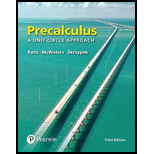
Concept explainers
In Exercises 35—42, show that f and g are inverses of each other by verifying that
Want to see the full answer?
Check out a sample textbook solution
Chapter 1 Solutions
Pearson eText for Precalculus: A Unit Circle Approach -- Instant Access (Pearson+)
- When f(x) = x² + 4x + 3, evaluate f( – 1) )arrow_forwardDerive f(x): = x6-x+1 x6 +x+1arrow_forward9) Let f(x) = (x + 2)² - 12. a) Sketch a "good enough graph" of f. b) Determine the number of solutions to the equation f(x) = -3 using the graph in in a). c) Work backward (applying inverse functions) to the equation f(x) = -3 for x. x =arrow_forward
- Let f(x) = x² + 6x + 2arrow_forwardIn Exercises 1-10, find f(g(x)) and g((x)) and determine whether each pair of functions f and g are inverses of each other. 1. f(x) = 4x and g(x) = 4 2. f(x) = 6x and g(x) = 7 x - 8 3. f(x) = 3x + 8 and g(x) 3 X - 9 4. f(x) = 4x + 9 and g(x) 4 x +5 5. f(x) = 5x – 9 and g(x) 9 x + 3 6. f(x) = 3x – 7 and g(x) 7. f(x) : 3 and g(x) 3 + 4 X - 4 2 8. f(x) 2 and g(x) = = + 5 X - 5 9. f(x) = -x and g(x) = -x 10. f(x) = Vx – 4 and g(x) = x + 4arrow_forwardExercises 121–140: (Refer to Examples 12–14.) Complete the following for the given f(x). (a) Find f(x + h). (b) Find the difference quotient of f and simplify. 121. f(x) = 3 122. f(x) = -5 123. f(x) = 2x + 1 124. f(x) = -3x + 4 %3D 125. f(x) = 4x + 3 126. f(x) = 5x – 6 127. f(x) = -6x² - x + 4 128. f(x) = x² + 4x 129. f(x) = 1 – x² 130. f(x) = 3x² 131. f(x) = 132. /(x) 3D글 = = 132. f(: 133. f(x) = 3x² + 1 134. f(x) = x² –- 2 135. f(x) = -x² + 2r 136. f(x) = -4xr² + 1 137. f(x) = 2x - x +1 138. f(x) = x² + 3x - 2 139. f(x) = x' 140. f(x) = 1 – xarrow_forward
- Part B: If f(x) = x3 – 1 find f(3) and f(f-(7)).arrow_forward5. If f(x) = (x + 1)(x - 2) x 2 and g(x) = x + 1, does f(x) = g(x)? Explain.arrow_forwardIn Exercises 1-5, let f(x) = sin x, g(x) = x² + 1, and h(x) = 7x. Write a simplified expression for the composite function 1. f(g(x)) 2. f(g(h(x)) 3. (g o h)(x) 4. (ho g)(x) g(x) 5. f h(x)arrow_forward
- Find real numbers a, b, and c so that the graph of the function f(x) = ax2 +bx + c contains the points (-1, -6), (1, 4), and (2, 0). Use this model to predict f(4).arrow_forwardVerify that the factorization for f (x) = x3 + x2 + 1 over Z2arrow_forwardExample 3: Given f(x)=2x-1, determine f(f(x)) and f¯¹(ƒ(x)) Exercises: Determine the inverse of each function: -2 x + 5 a) y = -3x² +2 b) y=- c) y d) y = x-1 x + 3arrow_forward
 Calculus: Early TranscendentalsCalculusISBN:9781285741550Author:James StewartPublisher:Cengage Learning
Calculus: Early TranscendentalsCalculusISBN:9781285741550Author:James StewartPublisher:Cengage Learning Thomas' Calculus (14th Edition)CalculusISBN:9780134438986Author:Joel R. Hass, Christopher E. Heil, Maurice D. WeirPublisher:PEARSON
Thomas' Calculus (14th Edition)CalculusISBN:9780134438986Author:Joel R. Hass, Christopher E. Heil, Maurice D. WeirPublisher:PEARSON Calculus: Early Transcendentals (3rd Edition)CalculusISBN:9780134763644Author:William L. Briggs, Lyle Cochran, Bernard Gillett, Eric SchulzPublisher:PEARSON
Calculus: Early Transcendentals (3rd Edition)CalculusISBN:9780134763644Author:William L. Briggs, Lyle Cochran, Bernard Gillett, Eric SchulzPublisher:PEARSON Calculus: Early TranscendentalsCalculusISBN:9781319050740Author:Jon Rogawski, Colin Adams, Robert FranzosaPublisher:W. H. Freeman
Calculus: Early TranscendentalsCalculusISBN:9781319050740Author:Jon Rogawski, Colin Adams, Robert FranzosaPublisher:W. H. Freeman
 Calculus: Early Transcendental FunctionsCalculusISBN:9781337552516Author:Ron Larson, Bruce H. EdwardsPublisher:Cengage Learning
Calculus: Early Transcendental FunctionsCalculusISBN:9781337552516Author:Ron Larson, Bruce H. EdwardsPublisher:Cengage Learning





